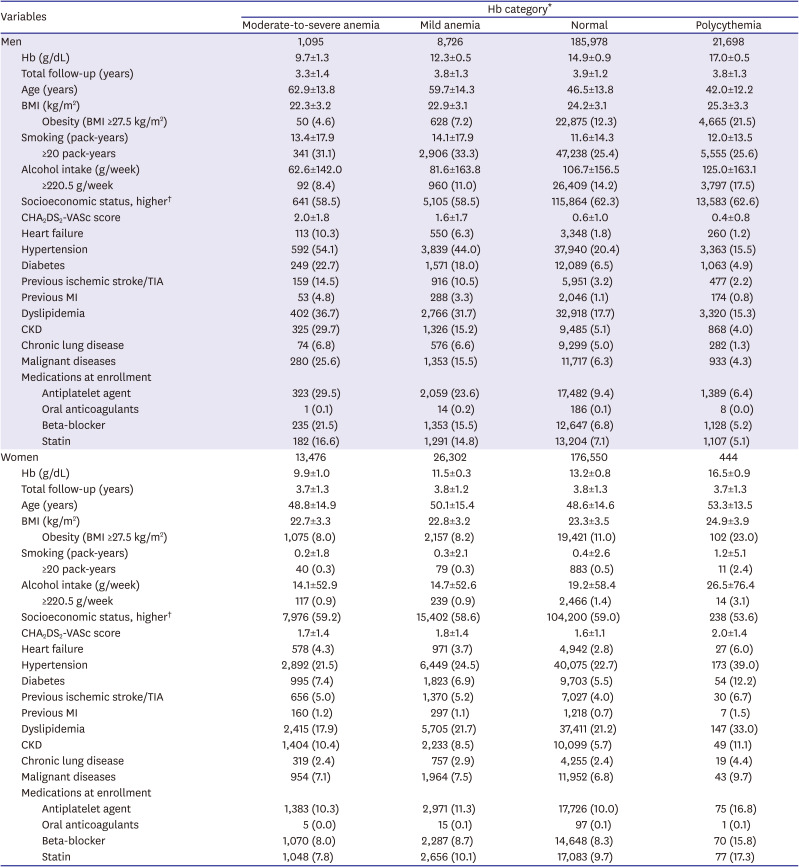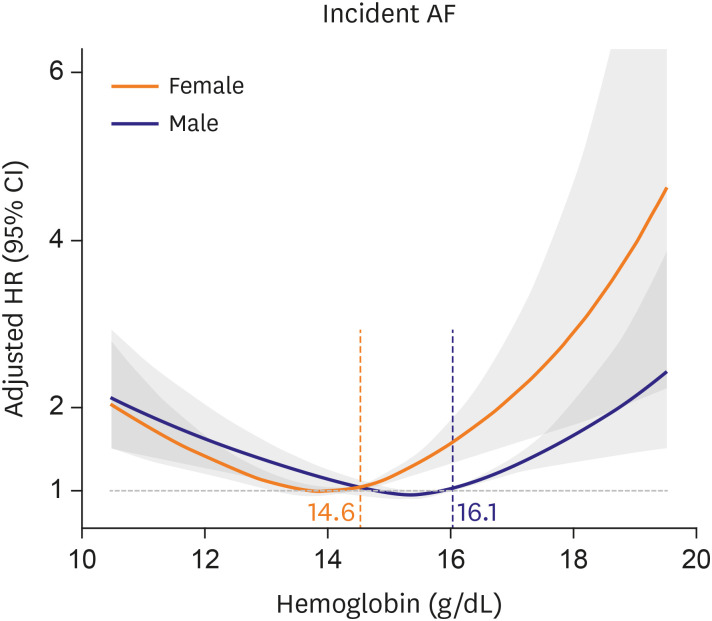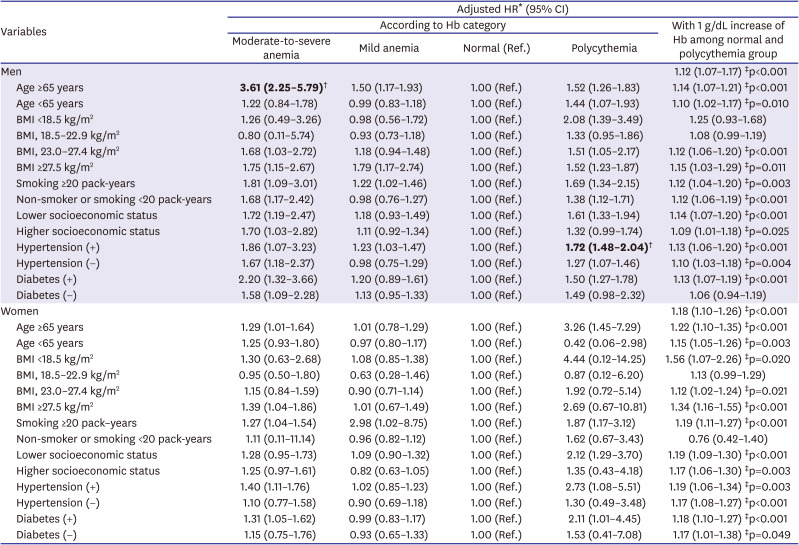1. McKechnie RS, Smith D, Montoye C, et al. Prognostic implication of anemia on in-hospital outcomes after percutaneous coronary intervention. Circulation. 2004; 110:271–277. PMID:
15226214.

2. Ponikowski P, Voors AA, Anker SD, et al. 2016 ESC Guidelines for the diagnosis and treatment of acute and chronic heart failure: The Task Force for the diagnosis and treatment of acute and chronic heart failure of the European Society of Cardiology (ESC)Developed with the special contribution of the Heart Failure Association (HFA) of the ESC. Eur Heart J. 2016; 37:2129–2200. PMID:
27206819.
3. Gotoh S, Hata J, Ninomiya T, et al. Hematocrit and the risk of cardiovascular disease in a Japanese community: the Hisayama study. Atherosclerosis. 2015; 242:199–204. PMID:
26204496.

4. Cetin MS, Ozcan Cetin EH, Balcı KG, et al. The association between whole blood viscosity and coronary collateral circulation in patients with chronic total occlusion. Korean Circ J. 2016; 46:784–790. PMID:
27826336.

5. Lim WH, Choi EK, Han KD, Lee SR, Cha MJ, Oh S. Impact of hemoglobin levels and their dynamic changes on the risk of atrial fibrillation: a nationwide population-based study. Sci Rep. 2020; 10:6762. PMID:
32317679.

6. Li H, Gu Y, Liu M, et al. The relationship between red blood cell distribution width and atrial fibrillation in Asian population: a cross-sectional study. Pacing Clin Electrophysiol. 2019; 42:1197–1203. PMID:
31397913.

7. Kim BG, Kim H, Hong SJ, et al. Relation of preprocedural hemoglobin level to outcomes after percutaneous coronary intervention. Am J Cardiol. 2019; 124:1319–1326. PMID:
31493827.

8. Malek AM, Alper SL, Izumo S. Hemodynamic shear stress and its role in atherosclerosis. JAMA. 1999; 282:2035–2042. PMID:
10591386.

9. Sullivan JL. Iron and the sex difference in heart disease risk. Lancet. 1981; 1:1293–1294. PMID:
6112609.

10. Fukumoto Y, Hiro T, Fujii T, et al. Localized elevation of shear stress is related to coronary plaque rupture: a 3-dimensional intravascular ultrasound study with in-vivo color mapping of shear stress distribution. J Am Coll Cardiol. 2008; 51:645–650. PMID:
18261684.
11. Gotsadze M, Narsia N, Momtselidze N, Mantskava M.Monitoring of hemorheological parameters in patients with atrial fibrillation (initial data). Georgian Med News. 2019; 59–63. PMID:
31322516.
12. Liu L, Gan S, Li B, Ge X, Yu H, Zhou H. Fisetin alleviates atrial inflammation, remodeling, and vulnerability to atrial fibrillation after myocardial infarction. Int Heart J. 2019; 60:1398–1406. PMID:
31666455.

13. Ku DN, Giddens DP, Zarins CK, Glagov S. Pulsatile flow and atherosclerosis in the human carotid bifurcation. Positive correlation between plaque location and low oscillating shear stress. Arteriosclerosis. 1985; 5:293–302. PMID:
3994585.

14. Langille BL, O'Donnell F. Reductions in arterial diameter produced by chronic decreases in blood flow are endothelium-dependent. Science. 1986; 231:405–407. PMID:
3941904.

15. von Elm E, Altman DG, Egger M, et al. The Strengthening the Reporting of Observational Studies in Epidemiology (STROBE) statement: guidelines for reporting observational studies. Ann Intern Med. 2007; 147:573–577. PMID:
17938396.

16. Lee J, Lee JS, Park SH, Shin SA, Kim K. Cohort profile: The National Health Insurance Service-National Sample Cohort (NHIS-NSC), South Korea. Int J Epidemiol. 2017; 46:e15. PMID:
26822938.

17. Kim IS, Yang PS, Lee J, et al. Long-term fine particulate matter exposure and cardiovascular mortality in the general population: a nationwide cohort study. J Cardiol. 2020; 75:549–558. PMID:
31839460.

18. Levey AS, Stevens LA, Schmid CH, et al. A new equation to estimate glomerular filtration rate. Ann Intern Med. 2009; 150:604–612. PMID:
19414839.

19. WHO Expert Consultation. Appropriate body-mass index for Asian populations and its implications for policy and intervention strategies. Lancet. 2004; 363:157–163. PMID:
14726171.
20. World Health Organization. Haemoglobin Concentrations for the Diagnosis of Anaemia and Assessment of Severity. Geneva: World Health Organization;2011.
21. Youden WJ. Index for rating diagnostic tests. Cancer. 1950; 3:32–35. PMID:
15405679.

22. Chao TF, Wang KL, Liu CJ, et al. Age threshold for increased stroke risk among patients with atrial fibrillation: a nationwide cohort study from Taiwan. J Am Coll Cardiol. 2015; 66:1339–1347. PMID:
26383720.
23. Kunnas T, Solakivi T, Huuskonen K, Kalela A, Renko J, Nikkari ST. Hematocrit and the risk of coronary heart disease mortality in the TAMRISK study, a 28-year follow-up. Prev Med. 2009; 49:45–47. PMID:
19409924.

24. Salazar Vázquez BY, Cabrales P, Tsai AG, Johnson PC, Intaglietta M. Lowering of blood pressure by increasing hematocrit with non nitric oxide scavenging red blood cells. Am J Respir Cell Mol Biol. 2008; 38:135–142. PMID:
17709601.
25. Kim M, Hong M, Kim JY, et al. Clinical relationship between anemia and atrial fibrillation recurrence after catheter ablation without genetic background. Int J Cardiol Heart Vasc. 2020; 27:100507. PMID:
32258364.

26. Holsworth RE Jr, Cho YI, Weidman JJ, Sloop GD, St Cyr JA. Cardiovascular benefits of phlebotomy: relationship to changes in hemorheological variables. Perfusion. 2014; 29:102–116. PMID:
24045034.

27. Kameneva MV, Watach MJ, Borovetz HS. Rheologic dissimilarities in female and male blood: potential link to development of cardiovascular diseases. Adv Exp Med Biol. 2003; 530:689–696. PMID:
14562767.

28. Lippi G, Cervellin G, Sanchis-Gomar F. Red blood cell distribution width: a marker of anisocytosis potentially associated with atrial fibrillation. World J Cardiol. 2019; 11:292–304. PMID:
31908729.

29. Wolters FJ, Zonneveld HI, Licher S, et al. Hemoglobin and anemia in relation to dementia risk and accompanying changes on brain MRI. Neurology. 2019; 93:e917–26. PMID:
31366722.

30. Diamond PT, Gale SD, Evans BA. Relationship of initial hematocrit level to discharge destination and resource utilization after ischemic stroke: a pilot study. Arch Phys Med Rehabil. 2003; 84:964–967. PMID:
12881817.










 PDF
PDF Citation
Citation Print
Print



 XML Download
XML Download